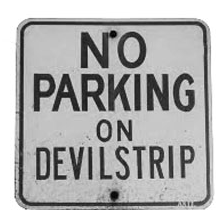On the Devilstrip
 As a small child in Akron, Ohio, I enjoyed the thrill of riding trikes and bikes up and down the block. But joy was tempered by a rule. We kids were told to stay off the “devilstrip,” the forbidden strip of grass that separated the safe environment of the sidewalk from the dangers of the street. Outside of Akron, I later discovered, the useful word “devilstrip” was unknown. It was missing from dictionaries, except for one — the Dictionary of American Regional English, a charming collection of regional terms that confirmed that only people in Northeastern Ohio used the word “devilstrip.” But publication of volumes after the one with “D” was *very* slow. Last week — finally! — the news media –Reuters, NPR, Wall Street Journal and others — heralded the publication of the long-awaited fifth and final volume of the Dictionary of American Regional English (DARE), which concluded spunkily with “zydeco.”
As a small child in Akron, Ohio, I enjoyed the thrill of riding trikes and bikes up and down the block. But joy was tempered by a rule. We kids were told to stay off the “devilstrip,” the forbidden strip of grass that separated the safe environment of the sidewalk from the dangers of the street. Outside of Akron, I later discovered, the useful word “devilstrip” was unknown. It was missing from dictionaries, except for one — the Dictionary of American Regional English, a charming collection of regional terms that confirmed that only people in Northeastern Ohio used the word “devilstrip.” But publication of volumes after the one with “D” was *very* slow. Last week — finally! — the news media –Reuters, NPR, Wall Street Journal and others — heralded the publication of the long-awaited fifth and final volume of the Dictionary of American Regional English (DARE), which concluded spunkily with “zydeco.”
The Dictionary is largely based on interviews conducted between 1965 to 1970 in more than 1,000 communities. Researchers in the project “asked Americans about their ways of talking about kitchen implements, housing, animals, diseases, food, music and more,” netting more than 2.3 million responses for editors to process (http://dare.wisc.edu ). Out of so many terms, it’s hard to pick examples, but here are a few that I like the sound of: “pogonip” — a dense icy fog — Native American origin, from Nevada; “pungle” – to shell out (money)– mangled from the Spanish, used in the West; “rantom scoot” — an outing with no particular destination, from New England.
The DARE website (http://dare.wisc.edu) is worth a visit. There are quizzes that will expose you to all sorts of peculiar terms to add to your vocabulary. The editors also claim surprising practical uses for the dictionary: “… physicians use DARE to understand the folk and regional terms used by their patients for ailments and diseases; natural scientists use DARE to identify plants and animals based on regional and folk names…actors and dialect coaches use DARE’s audio collection to perfect their regional accents.”
Ironically, even as DARE reaches its last volume, it has become very easy to look up a large percentage of the once-obscure, colorful regional terms that it contains through a simple Google search. Regionalisms appear to be a perfect subject for crowdsourcing on the Internet, where you’ll find definitions and lots of chatter, sometimes citing a DARE definition. And regional linguistic loyalty abounds! For example, the local-culture blog “An Akronism” rhapsodizes on what is, after all, Akron’s only contribution to regional English, while disparaging as “false names” various insipid synonyms for “devilstrip” — tree lawn, tree strip, sidewalk buffer, city grass, and the like. (http://uakronpress.wordpress.com/2010/05/26/akronisms-the-devilstrip)
DARE itself will soon hop onto the Internet; electronic publication is scheduled for 2013. So it will be ever easier to find out about the strange terms Americans in various regions of the country have come up with to describe food, games, weather, work, the landscape, and other features of their lives, even if actual usage slips away.
Need to look something up right now? The Dictionary of Regional English is in the Linderman Reading room at 427.973 D554
— C. Roysdon